Lei Feng network: This article was originally published in the column of semiconductor technology.
In the previous article we talked about the principle of what dual Cameras can do and the various functions of dual cameras. Now we will focus on the dual Camera industry.
| Dual Camera Algorithm Supplier
Because the algorithm needs to cooperate with the ISP, the algorithm and the ISP are mutually complementary. If you want to do the algorithm well, you must also have a good ISP.
As the main platform vendor, Qualcomm/MediaTek has its own ISP, so it has also developed its own Dual Camera algorithm. As for the good or bad of its algorithm, it has yet to be tested by the market.
As a supplier to Sensors, Sony, Samsung, and OV are also actively developing dual-camera algorithms, and they haven't seen mass-produced products for the time being. However, in the era of functional machines, there is no ISP. When these Camera sensor suppliers are doing 2M/5M, they have to match their own ISP, so these suppliers have their own experience in developing ISPs. Therefore, the development of dual Camera algorithm is relatively related to experience.
Apple acquired Linx last year and also has a multi-camera patent and algorithm. Whether it will be used in its own dual-Camera model, look at this year's iPhone7. Theoretically speaking, Linx has enough algorithms, so Apple will not buy dual camera licenses with a big factory.
In addition to these platforms, sensor suppliers and smart phone brand companies will develop dual camera algorithms. Other vendors will list them:

Founded in 1996 in Huajing, Taiwan, mainly develops independent ISP chips. Some high-end mobile phones, cameras, and cars have examples of their ISPs. Dual Camera phones also have their ISP's. Distance applications, optical zoom, and dimming compensation all contribute.

An Israeli company. The advantages of its algorithm are mainly in optical zoom and dim light compensation. In terms of depth of field, there is also some research. From the perspective of media promotion, the hTC organic type uses its algorithm.

Hongsoft was founded in 1994 and is headquartered in the United States. It has technology centers in Shanghai, Hangzhou and Nanjing. Rainbow's strengths are optical zoom and dimming compensation. The second optical zoom and dark light supplements in the previous article come from ArcSoft.

Shanghai Xingxinwei is a company established in 2011 and is mainly engaged in the research and development of image processors. Currently, the products are mainly used in the automotive market. As one of the few companies that develops independent ISPs, it is currently developing dual camera algorithms and ISPs. After the dual Camera market, X-Chip will be a very potential dark horse.
Dual Camera is also just out, so the algorithm, each has its own advantages and disadvantages. However, judging from the dual camera mobile phones that have already been launched, the algorithms of each camera have yet to be improved. After a variety of algorithmic capabilities have gone up, it is bound to make dual cameras the standard for mobile phones.
| Dual Camera sensor supplier
Since the Dual Camera needs two camera synchronized time stamps when taking pictures, it requires the Camera Sensor to have a synchronization signal. Sensors that currently have this synchronization signal are Sony, Samsung, OV, and Geko Micro. So the dual Camera's Sensor mainly uses these products.
| Dual Camera Module Supplier
At present, there are a lot of module factories that can make dual cameras, including Lite-On, Sunny, Trust, Namuga, O-Film, Samsung Electromechanical, and Titanium. However, there are mainly mass production experiences of Guangbao, Haoyu and Truly. Huawei's models mainly use Lite-On and Sunny's modules. O-Film and Samsung Electromechanics, with their strong factory capabilities, are now entering the field of dual Camera modules. Namuga maintains a good communication relationship with various algorithm companies, and is also a supplier of Samsung mobile phones, and is gradually making efforts in the field of dual Camera modules.
However, different functions have different requirements for modules. We continue to take an example of the four functions mentioned:
Distance application
The general approach is the size of the Camera, common Camera specifications such as 13M+2M, 13M+5M. As shown below:

Or is to put two Camera far, as shown below:
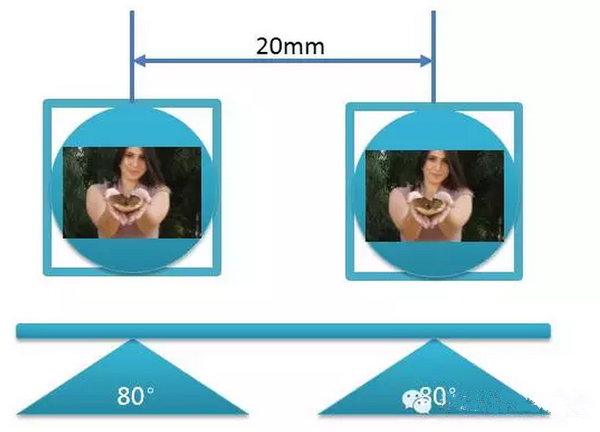
Through these two methods, the distance from the object to the lens can be better calculated.
optical zoom
The double-camera module of optical zoom, the most important thing is that the two cameras need different FOV(viewing range covered by the lens), similar to the following figure:
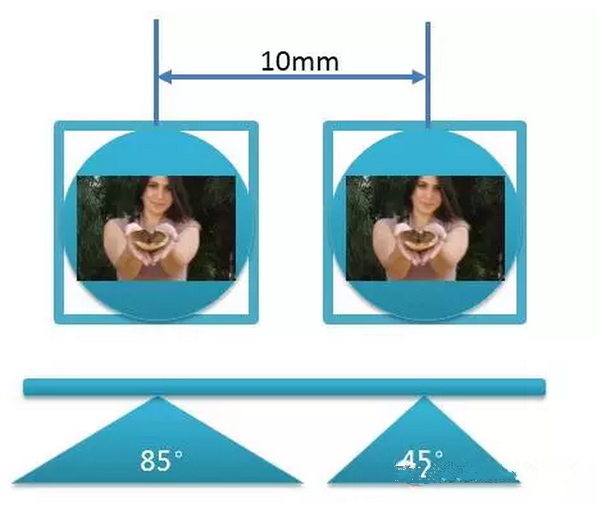
With different FOVs (viewing angle range covered by the lens), different focus points can be obtained, and then an optical zoom function can be achieved through an algorithm.
Dark light enhancement
The general dark light enhancements are shot with an RGB full-color Camera + a MONO black-and-white Camera, as shown below:
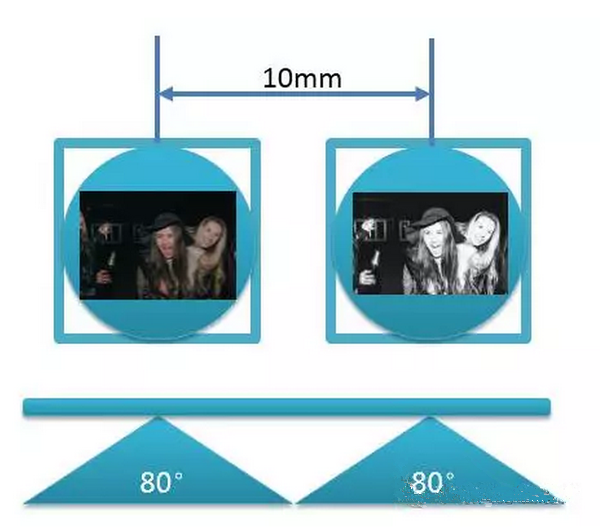
In terms of algorithm, the amount of incoming light is mainly read by the black and white Camera on the right, thereby compensating for the color of the left RGB Camera.
3D shooting and modeling
This approach is somewhat similar to distance-related modules. Only 3D has higher precision for distance. In this case, the distance between the two Cameras needs to be further away. Some of them even use infrared-assisted positioning to achieve distance measurement, and finally achieve 3D shooting and modeling.
| Difficulties in Dual Camera Module Making
Double Camera practice, there are two general: a total of substrate, or a total of stents. As shown below:
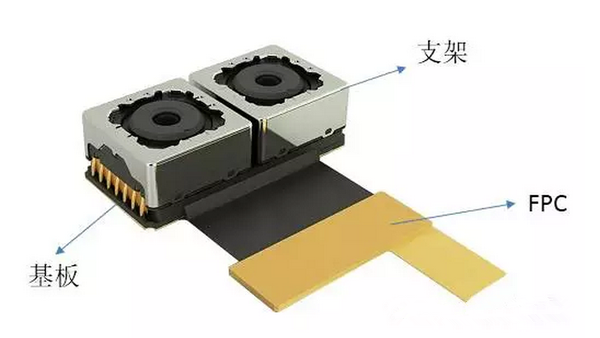
If a common substrate is used, the two Camera Sensors are placed on the same substrate, and then an FPC (a flexible circuit board with a bendable) can be drawn from the substrate.
If there is a common bracket, as shown in the figure above, the Sensor is fixed by the bracket and each sensor has its own substrate and its own FPC (a kind of flexible circuit board that can be bent).
The advantages of a common substrate: The two sensors can sit on the same plate and resist falling.
The disadvantage of the common substrate: low yield, resulting in expensive.
The advantages of a total stent: high yield, low prices.
Disadvantages of the common bracket: Because it is two independent Sensor modules, it needs to be in the same plane through AA calibration, which is difficult and has a poor fall resistance.
In short, both methods have their own advantages and disadvantages. At present, only Huawei uses a common substrate method. But either way, the current yield rate is poor, so the cost is still very high.
| Dual camera future
If the algorithm is improved and the yield rate of the module is improved, the Dual Camera still has many advantages worthy of everyone to do.
However, due to the different requirements of different functions on the module placement, dual Camera is currently viewed, it may not be able to meet everyone's requirements for Camera.
Since Google launched Project Tango, it was smart to propose a concept of three cameras:
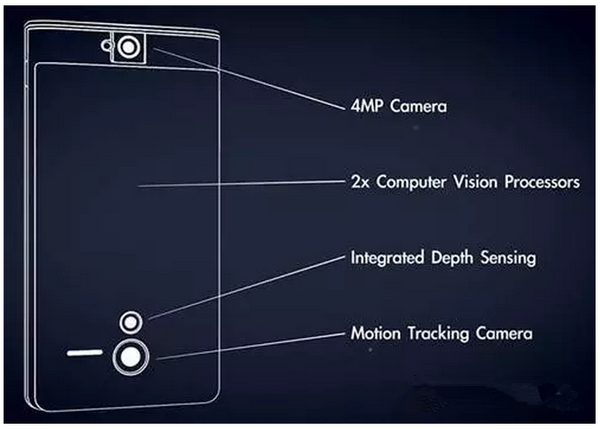
When distance measurement and 3D modeling are required, two distant Cameras can be used; if optical zoom and dimming compensation are used, two close-range lenses can be used. Even this Depth Sense can combine infrared to measure distance more accurately.
In any case, with the evolution of the Dual Camera algorithm and the increase in VR demand, the role played by the Camera is increasing. Dual Camera, even the first dual Camera+ after three Camera phones.
Related Reading
Double camera depth analysis (on)
Lei Feng Network (search "Lei Feng Net" public concern) Note: This article was authorized by the author Zhang Jingyang release Lei Feng network. Zhang Jingyang, founder and CEO of Moore Elite. Reproduced please contact the authorizing and retain the source and the author, not to delete the content.